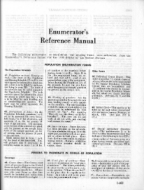1950 Census Instructions to Enumerators
1950 Census Instructions to Enumerators
The below text is excerpted on pages 66-71 from Measuring America: The Decennial Censuses From 1790 to 2000.
1950 Questionnaire - General Population
The basic schedule, form P1, was a white 19″ X 22″ sheet, printed in green ink on both sides. The front included space for population information for 30 persons, with a separate line for each person enumerated. (The reverse side, the housing schedule, contained spaces for information for 12 dwelling units that housed the persons enumerated on the population side of the form.) Questions 15 through 20 were asked only for persons 14 years of age and over. Questions at the bottom of the schedule (21-33c) were asked for the one person in five whose name fell on a sample line that was indicated in black. (There were five printings to vary the sample lines.) The person whose name fell on the last sample line was also asked the additional questions from 34 on. Of the sample items, Nos. 29 on applied only to persons 14 years of age and over.
Instructions to Enumerators
Changes from 1940 were few. Special pains were taken in the 1950 census, however, to distinguish among institutions, households, and quasi households (five or more nonrelatives of the head, other than employees).
College students were to be enumerated where they lived while attending school, rather than where their homes were located. Members of the Armed Forces who slept off post would be counted where they slept rather than where they were stationed.
The instructions continued to allow anyone to be designated as head of the household for relationship purposes, but if a woman was listed as head and her husband was present, he was reclassified as the head when the completed schedule was reviewed in the office. (At the time, the number of such cases was relatively small.)
A ‘‘family’’ was distinguished from a ‘‘household’’ in that the family represented a group of two or more persons related by blood, marriage, or adoption. A household could contain one or more families, or none, but would occupy only one dwelling unit (quarters with separate cooking equipment or (new for 1950) a separate entrance.)
As in 1940, there was a separate form a respondent could use to report income. However, this was now a selfmailing piece (form P6) which the householder was asked to complete and post (rather than hand it to the enumerator).
A supplemental schedule (form P8) was used to obtain additional information on Indian reservations. In addition to entering each person’s name as it appeared on the regular schedule, the enumerator wrote in any other name(s) by which that person was known.
1950 Questionnaire - Housing
Instructions to Enumerators
The census takers continued to define ‘‘nondwelling-unit quarters’’ (item 3) as they had in 1940, including as dwelling units those places with fewer than 10 lodgers. However, in subsequent office coding, any residence with 5 to 9 lodgers was reclassified as a nondwelling unit and excluded from the housing inventory. Vacant trailers, tents, boats, etc., were not enumerated.
There were detailed instructions for classifying various facilities (such as plumbing), equipment, and rooms for inclusion in the census.
In item 7 (condition of unit), the enumerator had to decide whether or not the place was ‘‘dilapidated,’’ which, in conjunction with the information on plumbing facilities (items 10-13) would provide an indicator of housing quality. The reference manual had a special illustrated section devoted to item 7 and training was augmented with a filmstrip. With this background, ‘‘dilapidated’’ or ‘‘not dilapidated’’ was to be checked without asking the householder about the condition of the unit. The decision was to be made on the basis of observation, looking for critical and minor housing deficiencies or for the adequacy of the original construction. A dilapidated unit, the census taker was told, was ‘‘below the generally accepted minimum standard for housing.’’ It failed to protect the occupants from the elements or endangered their health or safety. It could be dilapidated because it had been neglected or because the original construction had been inadequate in the first place. A unit was not to be reported as ‘‘dilapidated’’ simply because it was old or dingy, nor was it ‘‘not dilapidated’’ because it happened to be freshly painted or shingled over.
Items 14 and 15 were five different sets of questions, and each household answered the set found on the line on which it was enumerated (thus constituting a 20-percent sample for these items).





